Leonardo Semplici might be an unknown coach for those not following Italian football closely. That could change soon. Semplici has had a stunning rise away from the limelight and is currently impressing at SPAL. This tactical analysis will look at his attacking ideas and his defensive setup.
Background
Leonardo Semplici was born in Florence and impressed in his first coaching stints at Sangimignano and Figline in the lower Italian leagues. The 51-year-old then had short stints at Arezzo and Pisa before working in Fiorentina’s academy. In December 2014, Semplici was appointed at SPAL, then in Lega Pro.
Semplici led them to promotion to Serie B in his first full season in 2015/16 and followed that up by securing back-to-back promotions as SPAL returned to Serie A for the first time in 49 years. Semplici then kept them up last season and is about to repeat the trick again this season. This success makes him an intriguing potential for some of the mid-table Serie A clubs.
Tactical analysis: Leonardo Semplici’s style of play
Semplici has utilised a 3-5-2 system at SPAL when attacking, and when defending the wing-backs drop to create 5-3-2 instead. If we look at the statistics, we can see that SPAL, used a very dominant style in attack as their average of 50.4% is equal to clubs like Lazio and Fiorentina, for example.
As we’ll see below, SPAL have one of the best build-up systems in Italy, but they often failed to convert their good overall play into goals since they only scored 44 goals. With better players, though, Semplici would probably see his teams score more.
Attacking structure: Positional play concepts
Semplici uses a variety of interesting concepts in attack. He wants his side to build attacks from the back and to quickly advance up the pitch with fast passing combinations. This has created a very exciting brand of vertical passing. It’s easy to spot some well-known positional play concepts in Semplici’s possession setup.
Firstly, he sets the team up in an impressive positional structure that creates maximum width, central players between the lines and numerical advantage in the first line. This setup can be seen below. I’ve highlighted the back three, the positioning of the three central midfielders, the wing-backs (black) and the two strikers.
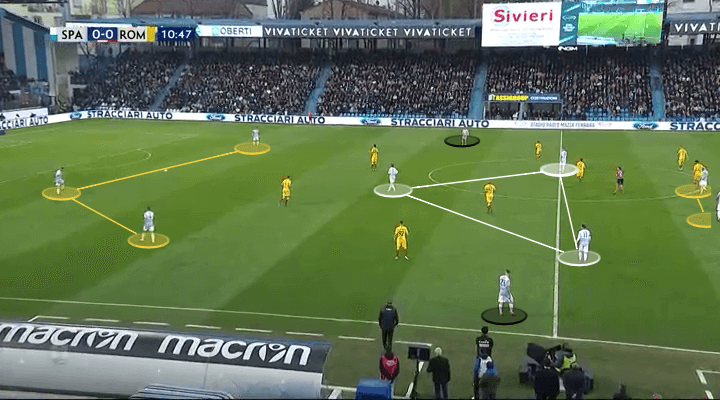
It’s very clear that Semplici wants his midfielders to get in between the lines of the opposition. It’s rare to see two of the three midfielders positioned on the same horizontal line. The defensive midfielder, Simone Missiroli in the image below, is always positioned behind the opponents first line of defence.
In the image below, we can clearly see how Missiroli positions himself between the lines of Roma’s attack and midfield. This is another concept in positional play; to have players positioned between the lines of the opposition.
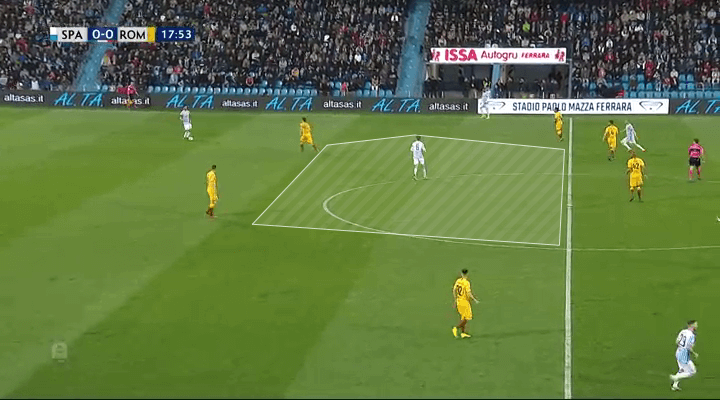
The defensive midfielder positions himself between the lines of the opponent’s attack and midfield to ensure the first line of pressure is broken when a pass is played into this position. The two more attacking midfielders, however, look for space between the opponent’s lines of midfield and defence. In the image below you can clearly see the positioning of Alessandro Murgia and Jasmin Kurtić behind Roma’s midfield. Furthermore, they are positioned in either half-space.
This is another aspect of positional play; using all five vertical corridors. SPAL’s midfield does this with the wing-backs in the wide spaces, the defensive midfielder in the central space and the attacking midfielders in the half-spaces.
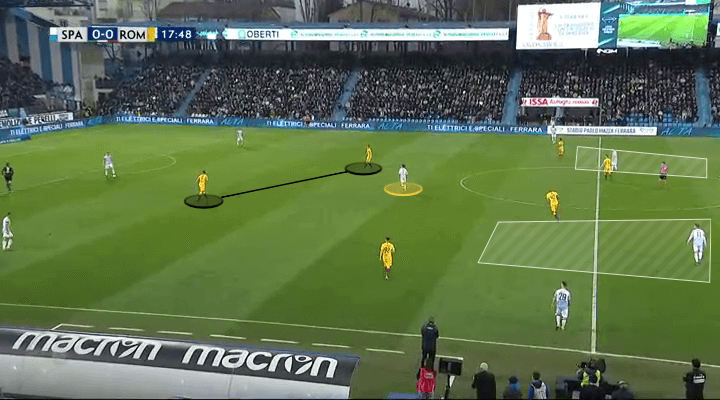
Semplici wants the defensive midfielder to control the attacking play. That’s why he likes playmakers like Pasquale Schiattarella and Missiroli in this position. Understandably, opponents often look to cut off access to this player, so SPAL are forced to find different ways of freeing up this player. One way they go about doing this is by using the third-man concept, which is another integral part of positional play. The image below highlights this method.
The pressing run of Nainggolan cuts off access to Schiattarella. The centre-back plays the ball into Valoti, and he lays it off to Schiattarella who can then switch the point of attack. The high positioning of the attacking midfielders is important here, as their positioning creates the space for them to drop into to receive the first pass.
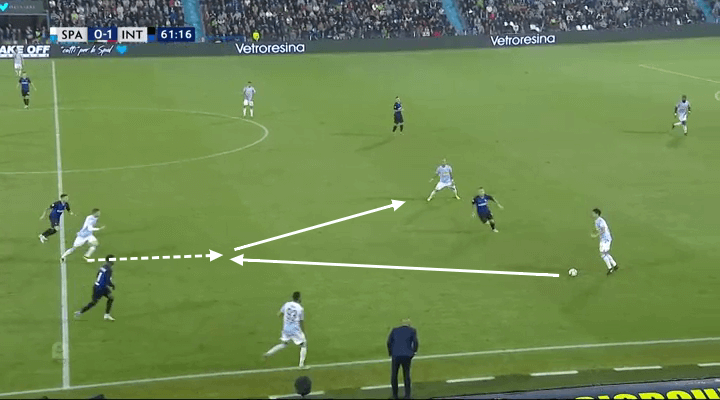
We have another example in the image below. The ball is played into Kurtić, who lays it off to Missiroli. The elegant Italian then has plenty of time to continue the attack down the right with Murgia (#11) perfectly positioned in the half-space and Lazzari wide.
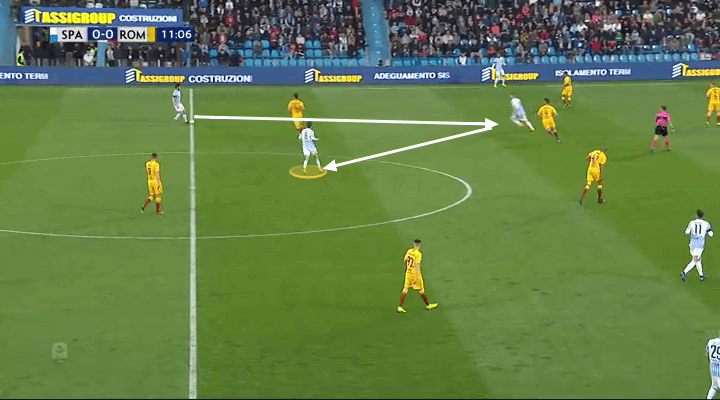
SPAL always look to build from the back, even when they are put under pressure. The image below highlights an interesting way they sometimes use to get out of pressure. SPAL’s outer centre-backs have dropped deep to become options. Inter have matched the three SPAL defenders with three attackers.
The defensive midfielder Schiattarella then drops in alongside Djourou to create a 4v3 advantage. He receives the ball from the goalkeeper Alfred Gomis, attracts the press from the Inter midfielder Borja Valero and lays it off Djourou. The Swiss defender can then step forward with the ball and Inter’s press has been broken.
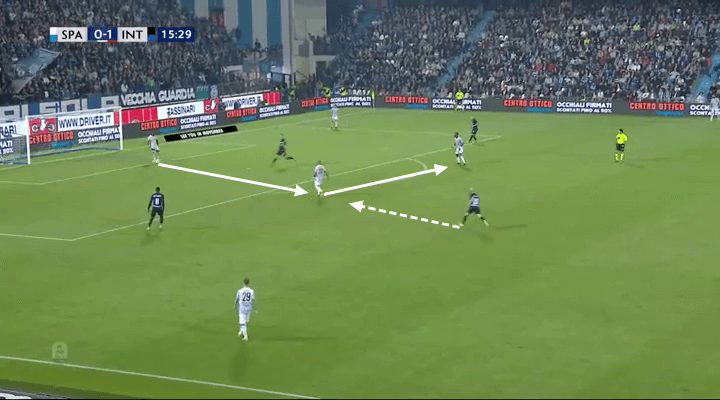
Most of SPAL’s attacks (43%) see them attacking down their right wing. There are plenty of reasons for this. Firstly, they have one of Italy’s best wing-backs, Manuel Lazzari. Secondly, they have plenty of central players with three centre-backs and three central midfielders. They try to build attacks centrally which means opponents have to focus on closing the central areas. This then, of course, opens up the flanks.
The below image is the result of the previous image with Djourou stepping out with the ball. Here he has just played it into Valoti who instantly lays it off to Missiroli in the right-sided half-space. Immediately, Missiroli sprays it wide to Lazzari as SPAL look to use the right wing.
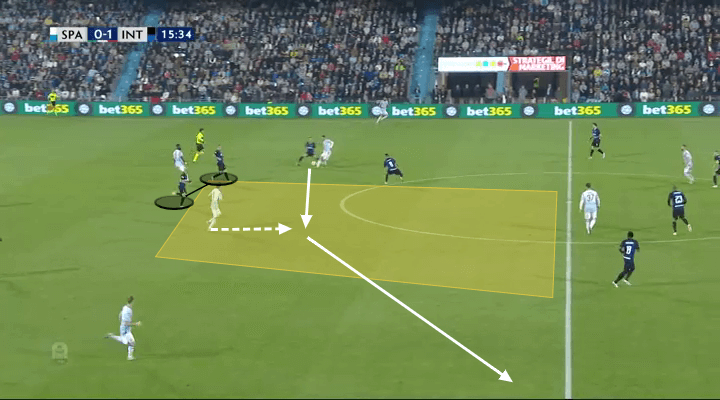
When advancing towards the penalty area, Semplici wants his wide men to put crosses into the box whenever possible. Crossing is SPAL’s main source of chance creation. In fact, only Inter (29) average more crosses per game than SPAL’s 23. To make the most out of these crosses, Semplici often looks to fill the box with both strikers, the far-side central midfielder and the wing-back on the opposite side.
Defensive setup: Aggressive man-orientated pressing…
Semplici’s pressing schemes are usually very aggressive. We can see a very good example of this in the image below. Semplici implements a heavily man-orientated high press where SPAL look to mark every player inside the opposition half as they look to build from the back.
In the below image, SPAL mark every Inter player coming deep to receive the ball. I’ve highlighted a big empty space behind the midfield. This is a space they are happy to give up since very few teams have goalkeepers that would look to play the ball into there.
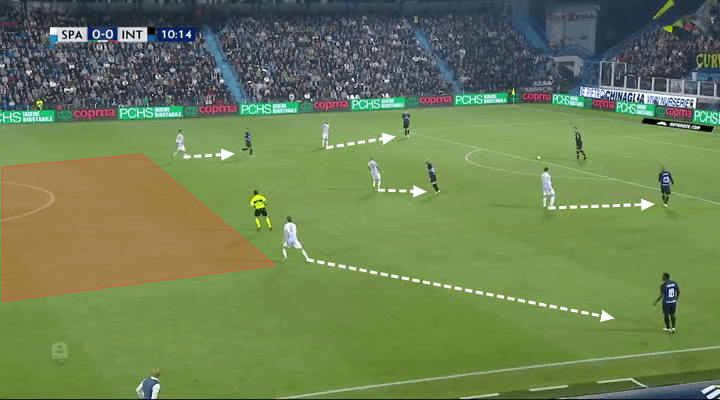
Below is another example of Samir Handanović in possession where SPAL mark every single Inter player as the visitors look to play out from the back.
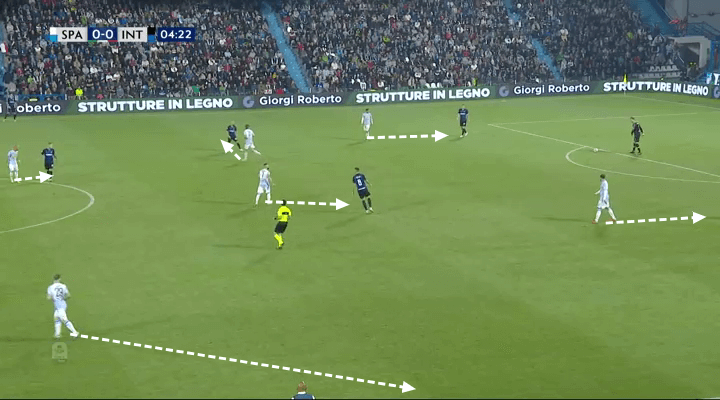
Semplici also used a similar template away at Inter when he looked to restrict their opportunities to build from the back. In the image below we can see how the front two splits to mark the centre-backs while the midfielder Missiroli pushes up to mark Brozović.
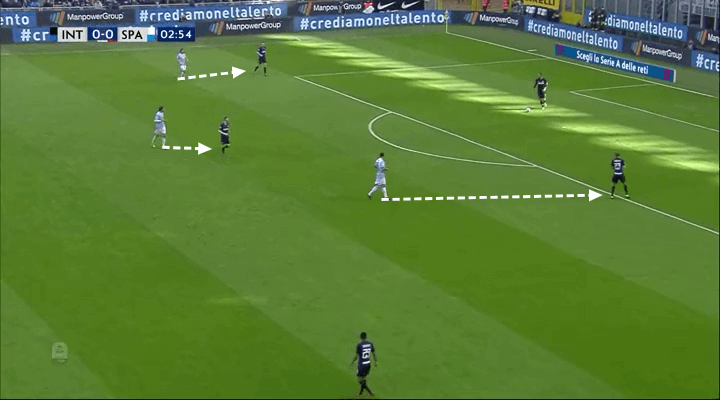
Semplici’s aim is usually to force the opponent to go wide where it’s easier to press them. The situation below highlights this as the striker Mirko Antenucci angles his run to force the pass to go to Roma’s right-back. Kurtiić then quickly sprints out to press. Also, note the man orientations in midfield from the other two central midfielders.
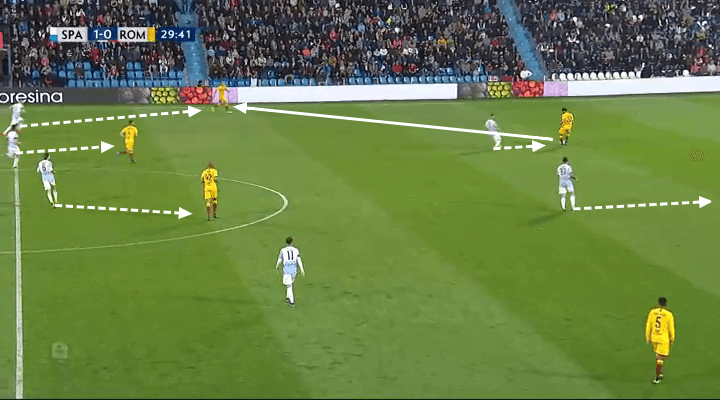
This aggressive pressing approach often leads to SPAL’s opponents having difficulties to build attacks from the back. However, it’s also quite risky. If the press doesn’t work as planned, SPAL have committed plenty of players forward and risk being attacked with a numerical disadvantage as several players can be beaten by a long pass, for instance.
…or a narrow 5-3-2 low-block
When defending deeper, Semplici’s SPAL create a 5-3-2 formation where the midfield tries to stay narrow and prevent central progression for the opposition. As you can see below, the strikers also defend deep which creates a very compact defensive shape which is hard to play through.
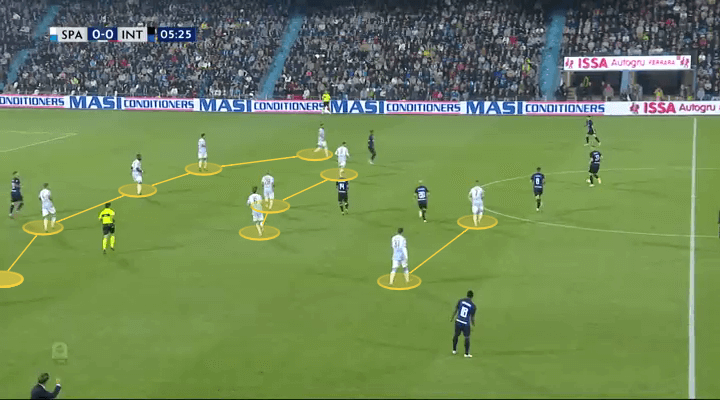
However, when defending in a 5-3-2 with a compact midfield you risk being forced into long shifts from side to side if the opponent can get control of possession. The below image highlights SPAL’s midfield and strikers. Nainggolan sprays the ball to the right wing instead, forcing the midfield to make a gruelling shift towards that side.
The issue is you have no one naturally pressing the opponent’s full-back as SPAL’s wing-back is pushed back by Inter’s winger. The ball is still outside your shape, but if you can’t shift across quickly enough, your opponents could potentially create a dangerous 2v1.
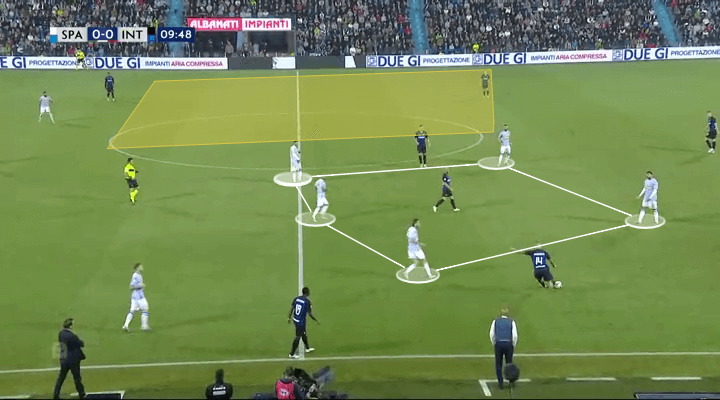
To deal with this, SPAL look to make strong overloads on the ball side. We can see an example of this below. The man-orientations remain, as you can clearly see. When they can create these overloads they make it really difficult for the opponent to progress the ball and it allows them to be in control of the game.
When the ball enters the wide areas we often see the wing-back press the opposition wide man with the near-side central midfielder providing cover. This allows SPAL to deal with wide threats reasonably well.
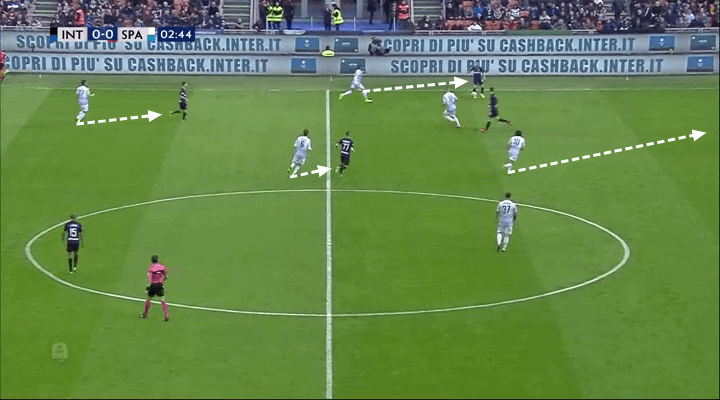
Conclusion
As this analysis has shown, Leonardo Semplici is a very interesting coach with a bright future in Italian football. His attacking ideas see positional play concepts and quick, vertical passing while his defensive setup is very man-orientated and aggressive. These ideas fit well with a potential move to a bigger club. With Gian Piero Gasperini possibly an option for bigger clubs at the end of the season, Semplici would be a good option for Atalanta.
If you love tactical analysis, then you’ll love the digital magazines from totalfootballanalysis.com – a guaranteed 100+ pages of pure tactical analysis covering topics from the Premier League, Serie A, La Liga, Bundesliga and many, many more. Buy your copy of the March issue for just ₤4.99 here, or even better sign up for a ₤50 annual membership (12 monthly issues plus the annual review) right here.

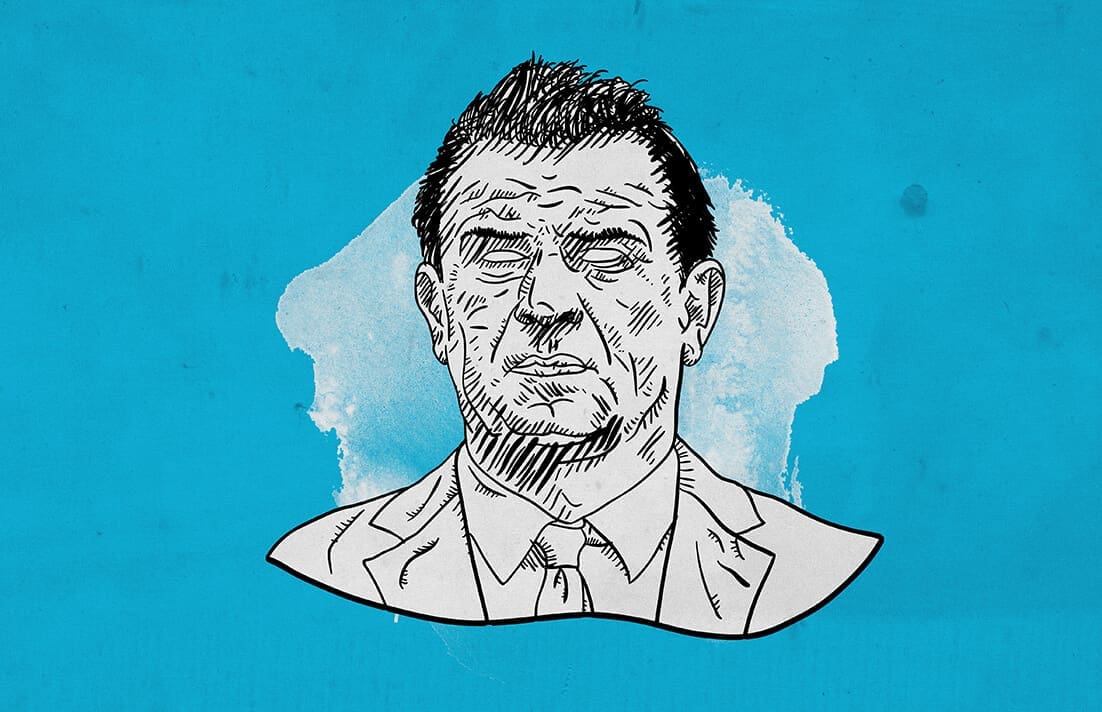



Comments